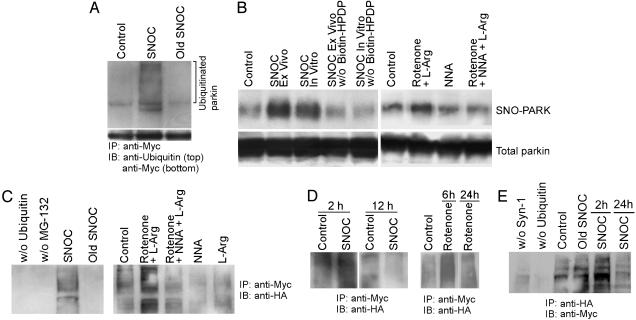Fig. 2.
Regulation of parkin E3 ubiquitin ligase activity by S-nitrosylation. (A) In vitro S-nitrosylation of parkin up-regulates its E3 ligase activity. (Upper) Lysates from parkin-overexpressing SH-SY5Y cells were immunoprecipitated with anti-myc antibody. The immunoprecipitates were incubated with SNOC (200 μM) and then subjected to in vitro ubiquitination reaction. SNOC increased the autoubiquitination of parkin, detected by anti-ubiquitin antibody. (Lower) Parkin loading control. (B) S-nitrosylation of parkin after SNOC or rotenone exposure. (Upper) Cell lysates from SH-SY5Y cells that had been exposed to SNOC (SNOC Ex Vivo) or rotenone (1 μM for 6 h) were subjected to the biotin-switch assay to detect SNO-PARK. Also, cell lysates were exposed to SNOC directly (SNOC In Vitro). Rotenone exposure was supplemented with l-arginine (labeled l-Arg) as a NOS substrate. Both SNOC and rotenone increased SNO-PARK in these assays. Nω-nitro-l-arginine (NNA) was used as a NOS inhibitor and suppressed SNO-PARK formation. (Lower) Parkin loading control. (C) Ex vivo S-nitrosylation of parkin up-regulates its E3 ligase activity. SH-SY5Y cells were transfected with HA-tagged ubiquitin and exposed to SNOC or rotenone to nitrosylate parkin. Cell lysates were then subjected to immunoprecipitation with anti-myc followed by Western blot analysis with anti-HA to detect autoubiquitinated parkin. NNA prevented the rotenone-induced increase in E3 ligase activity. (D) Effect of NO donor SNOC and rotenone on parkin E3 activity at different times. SH-SY5Y cells were exposed to SNOC or rotenone. At early time points (2 h after SNOC or 6 h after rotenone), parkin autoubiquitination increased compared with control but decreased several hours later. (E) Effect of NO donor on ubiquitination of synphilin-1 (Syn-1) by parkin. SH-SY5Y cells were cotransfected with HA-synphilin-1 and myc-ubiquitin and exposed to SNOC. Synphilin-1 ubiquitination increased 2 h after SNOC exposure but decreased 24 h later. Old SNOC, decayed SNOC.

